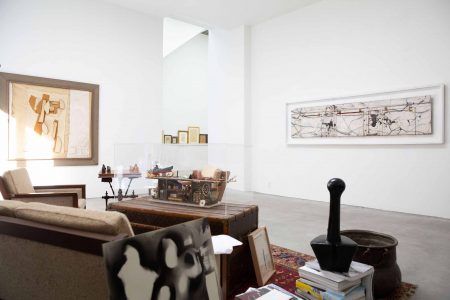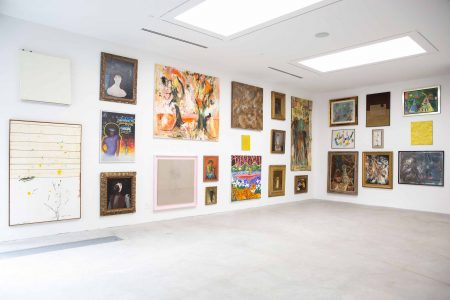Shin Gallery’s newest exhibition, Amalgamation: Celebrating 10 Years of Shin Gallery, on view until April 23, 2022, is perhaps one of the most unique gallery shows I have seen. This is due to both the exhibition’s a-chronological curatorship and the opportunity to view old masters and so-called “blue chip” art historical bastions alongside “outsider artists,” enterprising young artists, and rediscovered artists alike. As the title suggests, the exhibition marks the Lower East Side gallery’ ten-year anniversary exhibition. Dispersed throughout three gallery rooms—the first composed exclusively of drawings, the second a recreation of the gallerist’s living room, and the third a sprawling salon-style room—Amalgamation traverses both the decade-long development of Shin Gallery and illuminates an encyclopedic approach to curation.
The aforementioned bastions are wide-ranging, with the first room including Delacroix, Pollock, Emin, and Burden directly alongside putatively “outsider” artists like Bill Traylor and James Castle. This “drawing room” features one exception from drawing as such—a monoprint-on-cotton pillow by Emin titled Sleep (1998). Constructed two years prior to My Bed (1998), this shows Emin’s nascent interest in autobiographical themes like sexuality and mental health (notably, the phrase “TRACEY BE BRAVE” is etched into the pillow sheet). This is poised next to Egon Schiele’s drawing, Reclining Female Nude with Raised Legs (1918), a black crayon on paper work that is a personal favorite. The drawing features thick, angular lines that underscore the splayed woman’s muscular thighs—her left arm, draped in a slightly tucked shirt, burrows in between her legs and we can make our three of her fingers caressing her vulva and clitoris. This anonymous woman’s eyes are closed, and her long, stygian eyelashes bounce like fireflies lapping on a pond. Curated together—and in spite of their unique media and art historical moments—Emin and Schiele’s works unravel a shared interest in sexuality, sensuality and the meditative-cum-erotic act of laying alone, steeped in the uniquely feminine phenomenology of rapt self-pleasure.
The drawing room then continues with a number of sketches and portraits, including works by Ernest Mancoba, Joseph Stella, Honoré Daumier, Gustav Klimt, Joan Collette, Alan Sonfist, Willem De Kooning, Arshile Gorky, and Congo the chimpanzee, amongst many others. To do justice to all the works that make up Amalgamation would require a book’s length travail; consequently, I will solely focus on specific works throughout this review (in continuity with and honor of a particular approach to art criticism that my mentor, the late Daniel Brown, imparted upon me).
Moving to the second room, one is struck by how it is, in installation-like fashion, composed of relics and personal artworks from the gallerist, Hong Gyu Shin’s, private collection. Scattered artifacts, household furniture pieces, luggage, heirlooms, notes, letters, and dog-eared books frame the displayed artworks. One standout piece is Willem de Kooning’s painted wooden toilet seat, a 1954 untitled piece that features a distinctive contribution from Pollock. One cannot help but entertain the scatological here, which Pollock’s splatter-painting readily invites—indeed, this culls art historian Donald Kuspit’s apothegm that an artist’s vision spurns out of a “perverse, insane obsession with shit”. Kuspit’s psychoanalytic reading of art history is evinced by how this large, rectangular outhouse bathroom is littered with brown and black lineal splatches. Framed by antique lamps and wooden chairs plucked, this choice is particularly humorous. Viewers ought also note that Pollocks’ contribution in 1954 is of significance as the artist only made one (independent) painting that year, White Light, one of his last works.
Another interesting piece in this room is Chris Burden’s Warship (1981). This mixed-media assemblage, constructed the same year as A Tale of Two Cities (1981), is an alluring example of Burden’s continued interest in war toys, memorabilia, model buildings, antique soldiers, and history. The details that Burden has laced together include insignia and tokens from WWII, toy soldiers, a naval compass, crackled glass, and minute planes. It is a particularly crude, boyish work (a point of continuity with Burden’s earlier performance art), especially considering the swastika patch spearheading this ship. This second room also includes one of Hans Bellmer’s famous mannequin sculptures, La Poupee (1935). This is a rare opportunity to see one of Bellmer’s actual sculptures in person, rather than a photograph featuring his haunting, mesmerizing dolls. Bellmer’s acute and curious perversions reverberate in this magnificent, curious work: La Poupee could very well be the body of a woman simultaneously pregnant a dozen times over, globular breast-like arches spread like tumors through her torso, limbs amputated and rounded, an agape vagina in place of her lips. (Apparently, art collector Herbert Lust once donned the piece “the perfect woman”).
As aforementioned, the third room is curated in a salon-style, juxtaposing various media and art historical modalities. On the one hand are street artists like Kool Koor, Stan 153, and Richard Hambleton. On the other are portraits by Thomas Whistler, Joshua Johnson—the first recognized African-American artist in the US and an emancipated slave—and Thomas Eakins. Curated together together, these portraits span different art historical approaches to, and subjects of, portraiture, inviting viewers to consider what formalities are retained throughout these portraits and what continuities we might draw regarding the question of who gets to be portrayed. Johnson’s Portrait of a Woman (1763), as is to be expected for the era, is of an opulent white woman, her pallid face contrasted with a tangerine-orange dress and crimson ruby ring. One of my favorite curatorial choices is STAN 153’s Untitled (1989), which features an afro-donned black woman with gargantuan sunglasses that reflect the cityscape, bisecting two works by John D. Graham. STAN 153’s portrait is spray-painted and in graffiti-style while Graham’s more figurative portraits distend the depictee’s proportions and use thick, expressivist brush strokes. In turn, these are by no means classical portraits like those of Eakins and Whistler—the divergence in portraiture style is most riveting and rebellious, a hallmark of this curatorial approach.
Another personal favorite in the third room is the other Bellmer—this one a drawing titled In Memory (1963). There is some thematic continuity between this work and the Schiele, but this is perhaps my absolute favorite work from the show. In Memory hangs, tucked in a flesh-coral pink wooden frame that supplements the carnal subject matter. The drawing features a woman’s profile, thick oozing droplets of wet weeping down her nose, elfish ear, and cheek. Below her face was is her heart-shaped posterior, a leaf-like fabric blown upwards by an invisible wind, revealing a wide anus with a stream of liquid (presumably sperm) slipping out. In the woman’s hair hangs a team of small playful cherubs splayed on pillows, one of which Bellmer had the odd idea to partially fill in with a checkered pattern. This white-and-black quilted alcove is dispersed into an array of lines that, in comb-like fashion, sweep into the larger woman’s intestine-like locks. The cherubs are mostly female, an indissoluble array of faces rounded out by tufts of tawdry hair—slim bodies curved, positioned on their knees with bums upturn and arms wrapping into one another like the rinds of a wilting beanstalk. One holds the tip of the penis of another between her lips while a faintly sketched fellow cherub rides another. Notably, they are androgynous, if not intersex. Streams of that sticky, thick-droppled substance dribble and flow liberally, outpouring into a syrupy waterfall that rains down the protagonist’s face and hangs like glue from her nose and dangling pearls from her ears. Alongside its eroticism, the work is also technically masterful, with small details like articulated muscles and the rim of the ear perfectly constructed.
This salon-style room boasts works from established, young, and rediscovered artists alike, including Alan Sonfist, Beauford Delaney, Peyton Freiman, Andreas Emenius, J. F. Willumsen, Fedor Encke, Choong Sup Lim, and many more. Again, one cannot detail the entirety of this show, but a viewer could spend hours upon hours in this room alone. It is worth further underscoring, however, that not solely the works but the curation of the works makes Amalgamation a magnificent show. For there is a dominant method of meaning-making that seeps through the annals of history; according to this view, which one might deem the “customary view” of history, events can be tethered to one another to compose a protracted series of causes and effects. Insofar as visual culture and art history are concerned, so unspools a story that often begins with Mesopotamian pre-historical cave paintings, treks through Medieval illuminated manuscripts, frescos, artifacts and, by way of the archeological scalpel, traces a lineage that extends up through the Renaissance, Mannerism, Baroque art’s adumbrated shadows, Rococo’s opulence, the triad that is Neoclassicism, Romanticism, and Realism, up until 1865, when Manet’s Olympia jettisons us into Modernism with the sprawling figure of Titian’s Venus of Urbino (1538) appropriated to befit the contemporary moment that was the new modern world (of which Paris had become an index) while jesting with the past, dutifully robbing the art historical genre of the classical nude from its “mythic scaffolding” (as art historian Eunice Lipton famously put it). Following this “customary view”—which indeed still continues to be the received view in most art history programs, museums, and galleries, alike—we are then prodded through Modernist movements such as impressionism and post-impressionism up through the birth of postmodernism with Dada and, more specifically, Duchamp. This story can be told neatly, eventually positing us at the contemporary day.
While this customary view certainly has its merits, it is not the exclusive way to tell art history. The customary view glazes over points of problematization, breakage, and interruption, treating visual culture as a map of constancy rather than an arachnean latticework, a constellation of fissures and tension where what is retained and extolled is often done so due to the coeval sociocultural framing—i.e., those elite patrons and would-be writers of history who wield the power to herald and celebrate dominant narratives and chronologies. The alternative view to the customary view is the genealogical approach, which Amalgamation readily presents. The genealogical approach, philosophically proffered by Nietzsche and then brought to new heights by Foucault, recognizes that no retelling of history—and, in this specific case, art history—can be divorced from those who do the telling.
What is critical to Amalgamation adopting this approach is a deep interest in both those renowned artists whose names have duly reverberated through museum and gallery walls for decades and, at times, centuries, and those putatively “minor” artists who have been occluded from this chronicle. Thus, in this show one is privy to “outsider artists” like Purvis Young, Kool Koor, Stan 153, and Richard Hambleton curated alongside bastions like Egon Schiele, Man Ray, Marisol, François Boucher, Arshile Gorky, and Jackson Pollock. As I navigate the three rooms, I am struck by the curatorial decision to place artists and art historical moments that have traditionally been treated disparately, if treated at all, as inherently related and in communication with one another. This is much more intellectually stimulating to me than the story told by the “customary view,” for one cannot elucidate art and artists that exist and subsist at the extremities of power and history, rather than at the center, without simultaneously taking heed of certain methodological precautions. Many of the subaltern artists included in the show, like potter David Drake, have been unrecognized for much of art history, hushed by the “customary view” and its customary story-telling. For instance, juxtaposed by Whistler and Eakins, two bulwarks in the citadel of customary art history, Joshua Johnson’s art practice can be understood in conjunction with the historical conditions from which it was produced. Amalgamation admirably reminds us that which artwork is set next to which indirectly sculpts meaning-making and sets history into a mantle.
Shin Gallery, New York City. Through April 23, 2022




–Ekin Erkan



